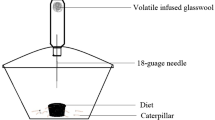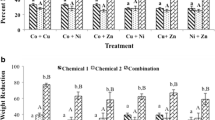Abstract
Insect herbivores can increase their detoxification activities against a particular plant poison in response to prolonged ingestion of the same compound. For example, larval tobacco hornworms (Manduca sexta) experience a dramatic increase in cytochrome P450 activity against nicotine after ingesting nicotine. While it is generally assumed that this induction process permits increased consumption of toxic plant tissues, we are not aware of any direct experimental support for this assumption. Using a two-tiered approach, we examined the functional significance of P450 induction to M. sexta larvae ingesting a toxic but non-deterrent concentration of nicotine. First, we related the time-course of P450 induction in midgut microsomes to changes in nicotine consumption. When offered a nicotine diet, larvae failed to show a significant increase in consumption before 36 h, which was coincident with the time-course of the induction of midgut P450 activities against aldrin and nicotine. Second, we determined whether inhibiting the induced P450 activities affected nicotine consumption. We found that the increase in nicotine consumption following the induction of nicotine metabolism could be strongly inhibited by treatment with piperonyl butoxide, which by itself did not inhibit consumption. These results provide direct evidence for a causal connection between P450-mediated detoxification activity and consumption of a toxic plant compound.
Similar content being viewed by others
Abbreviations
- PB :
-
piperonyl butoxide
References
Appel HM (1994) The chewing herbivore gut lumen: Physicochemical conditions and their impact on plant nutrients, allelochemicals, and insect pathogens. In: Bernays EA (ed) Insect-plant interactions, vol V. CRC Press, Boca Raton, pp 209–223
Appel HM, Martin MM (1992) Significance of metabolic load in the evolution of host specificity of Manduca sexta. Ecology 73: 216–228
Baldwin IT (1988) Short-term damage-induced increases in tobacco alkaloids protects plants. Oecologia 77: 378–381
Baldwin IT (1989) The mechanism of damage-induced alkaloids in wild tobacco. J Chem Ecol 15: 1661–1680
Bentz J-A, Barbosa P (1990) Effects of dietary nicotine (0.1%) and parasitism by Cortesia congregata on the growth and food consumption and utilization of the tobacco hornworm, Manduca sexta. Entomol Exp Appl 57: 1–8
Berenbaum MR, Cohen MB, Schuler MA (1992) Cytochrome P450 monooxygenase genes in oligophagous Lepidoptera. In: Mullin CA, Scott JG (eds) ACS Symposium Series 505. Washington, DC, pp 114–124
Brattsten LB (1992) Metabolic defenses against plant allelochemicals. In: Rosenthal GA, Berenbaum MR (eds) Herbivores: their interactions with secondary plant metabolites, Vol II. Ecological and evolutionary processes. Academic Press, New York, pp 176–242
Brattsten LB, Wilkinson CF (1973) Induction of microsomal enzymes in the southern armyworm (Prodenia eridania). Pestic Biochem Physiol 3: 393–407
Carino F, Koener JF, Plapp FW, Feyereisen R (1992) Constituitive overexpression of the cytochrome P450 gene CYP6A1 in the housefly, Musca domestica. In: Mullin CA, Scott JG (eds) ACS Symposium Series 505. Washington, DC, pp 31–40
Cohen MB, Schuler MA, Berenbaum MR (1992) A host plant inducible cytochrome P-450 from a host-specific caterpillar: Molecular cloning and evolution. Proc Natl Acad Sci USA 89: 10920–10924
Fernando-Warnakulasuriya GJP, Tsuchida K, Wells MA (1988) Effect of dietary lipid content on lipid transport and storage during larval development of Manduca sexta. Insect Biochem 18: 211–214
Feyereisen R, Vincent DR (1984) Characterization of antibodies to house fly NADPH-cytochrome P-450 reductase. Insect Biochem 14: 163–168
Feyereisen R, Koener JF, Farnsworth DE, Nebert DW (1989) Isolation and sequence of cDNA encoding a cytochrome P-450 from an insecticide-resistant strain of the house fly, Musca domestica. Proc Natl Acad Sci USA 86: 1465–1469
Feyereisen R, Andersen JF, Carino FA, Cohen MB, Koerner JF, Repecko S, Scott JA, Snyder MJ (1994) Insect cytochrome P450: Functions, regulation and diversity. In: Lechner MC (ed) Cytochrome P450: biochemistry, biophysics, and molecular Biology. John Libbey Eurotext, Paris, pp 31–36
Glendinning JI, (1996) Is chemosensory input essential for the rapid rejection of toxic foods? J Exp Biol (in press)
Glendinning JI, Slansky Jr F (1994) Interactions of allelochemicals with dietary constituents: effects on deterency. Physiol Entomol 19: 173–186
Glendinning JI, Slansky Jr F (1995) Consumption of a toxic food by caterpillars increases with dietary exposure: support for a role of induced detoxification enzymes. J Comp Physiol A 176: 337–345
Hansberry R, Middlekauff WW, Norton LB (1940) Toxicity of nicotine administered internally to several species of insects. J Econ Entomol 33: 511–517
Lagadic L, Cuany A, Bergé J-B, Echaubard M (1993) Purification and partial characterization of glutathione S-transferases from insecticide-resistant and lindane-induced susceptible Spodoptera littoralis (Boisd.) larvae. Insect Biochem Molec Biol 23: 467–474
Ma R, Cohen MB, Berenbaum MR, Schuler MA (1994) Black swallowtail (Papilio polyxenes) alleles encode cytochrome P450s that selectively metabolize linear furanocoumarins. Arch Biochem Biophys 310: 332–340
Maddrell SHP, Gardiner BOC (1976) Excretion of alkaloids by Malpighian tubules of insects. J Exp Biol 64: 267–281
Morris CE (1983) Uptake and metabolism of nicotine by the CNS of a nicotine-resistant insect, the tobacco hornworm (Manduca sexta). J Insect Physiol 29: 807–817
Morris CE (1984) Electrophysiological effects of cholinergic agents on the CNS of a nicotine-resistant insect, the tobacco hornworm (Manduca sexta). J Exp Zool 229: 361–374
Morris CE, Harrison JB (1984) Central nervous system features of a nicotine-resistant insect, the tobacco hornworm Manduca sexta. Tissue Cell 16: 601–612
Murray CL, Quaglia M, Arnason JT, Morris CE (1994) A putative nicotine pump at the metabolic blood-brain barrier of the tobacco hornworm. J Neurobiol 25: 23–34
Parr JC, Thurston R (1972) Toxicity of nicotine in synthetic diets to larvae of the tobacco hornworm. Ann Entomol Soc Am 65: 1185–1188
Prasad SV, Ryan RO, Law JH, Wells MA (1986) Changes in lipoprotein composition during larval-pupal metamorphosis of an insect, Manduca sexta. J Biol Chem 261: 558–562
Saitoh F, Noma M, Kawashima N (1985) The alkaloid content of sixty Nicotiana species. Phytochemistry 24: 477–480
Schoonhoven LM, Meerman J (1978) Metabolic cost of changes in diet and neutralization of allelochemicals. Entomol Exp Appl 24: 489–493
Self LS, Guthrie FE, Hodgson E (1964) Adaptation of tobacco hornworms to the ingestion of nicotine. J Insect Physiol 10: 907–914
Shah AH, Guthrie FE (1970) Penetration of insecticides through the isolated midgut of insects and mammals. Comp Gen Pharmac 1: 391–399
Snyder MJ, Hsu E-L, Feyereisen R (1993) Induction of cytochrome P450 activities by nicotine in the tobacco hornworm, Manduca sexta. J Chem Ecol 19: 2903–2916
Snyder MJ, Walding JK, Feyereisen R (1994) Metabolic fate of the allelochemical nicotine in the tobacco hornworm, Manduca sexta. Insect Biochem Molec Biol 24: 837–846
Snyder MJ, Walding JK, Feyereisen R (1995a) Glutathione S-transferases from larval Manduca sexta midgut: sequence of two cDNAs and enzyme induction. Insect Biochem Molec Biol 25: 455–465
Snyder MJ, Stevens JI, Andersen JF, Feyereisen R (1995b) Expression of cytochrome P450 genes of the CYP4 family in midgut and fat body of the tobacco hornworm, Manduca sexta. Arch Biochem Biophys (in press)
Tate LG, Nakat SS, Hodgson E (1982) Comparison of detoxification activity in midgut and fat body during fifth instar development of the tobacco hornworm, Manduca sexta. Comp Biochem Physiol 72C: 75–81
Trimmer BA, Weeks JC (1989) Effects of nicotinic and muscarinic agents on an identified motoneurone and its direct afferent inputs in larval Manduca sexta. J Exp Biol 144: 303–337
Author information
Authors and Affiliations
Rights and permissions
About this article
Cite this article
Snyder, M.J., Glendinning, J.I. Causal connection between detoxification enzyme activity and consumption of a toxic plant compound. J Comp Physiol A 179, 255–261 (1996). https://doi.org/10.1007/BF00222792
Accepted:
Issue Date:
DOI: https://doi.org/10.1007/BF00222792




